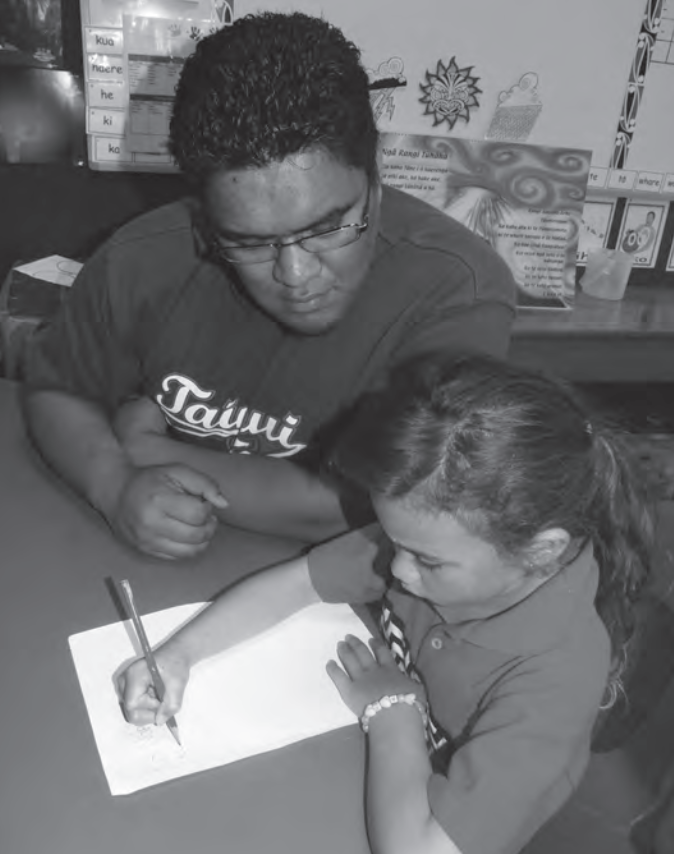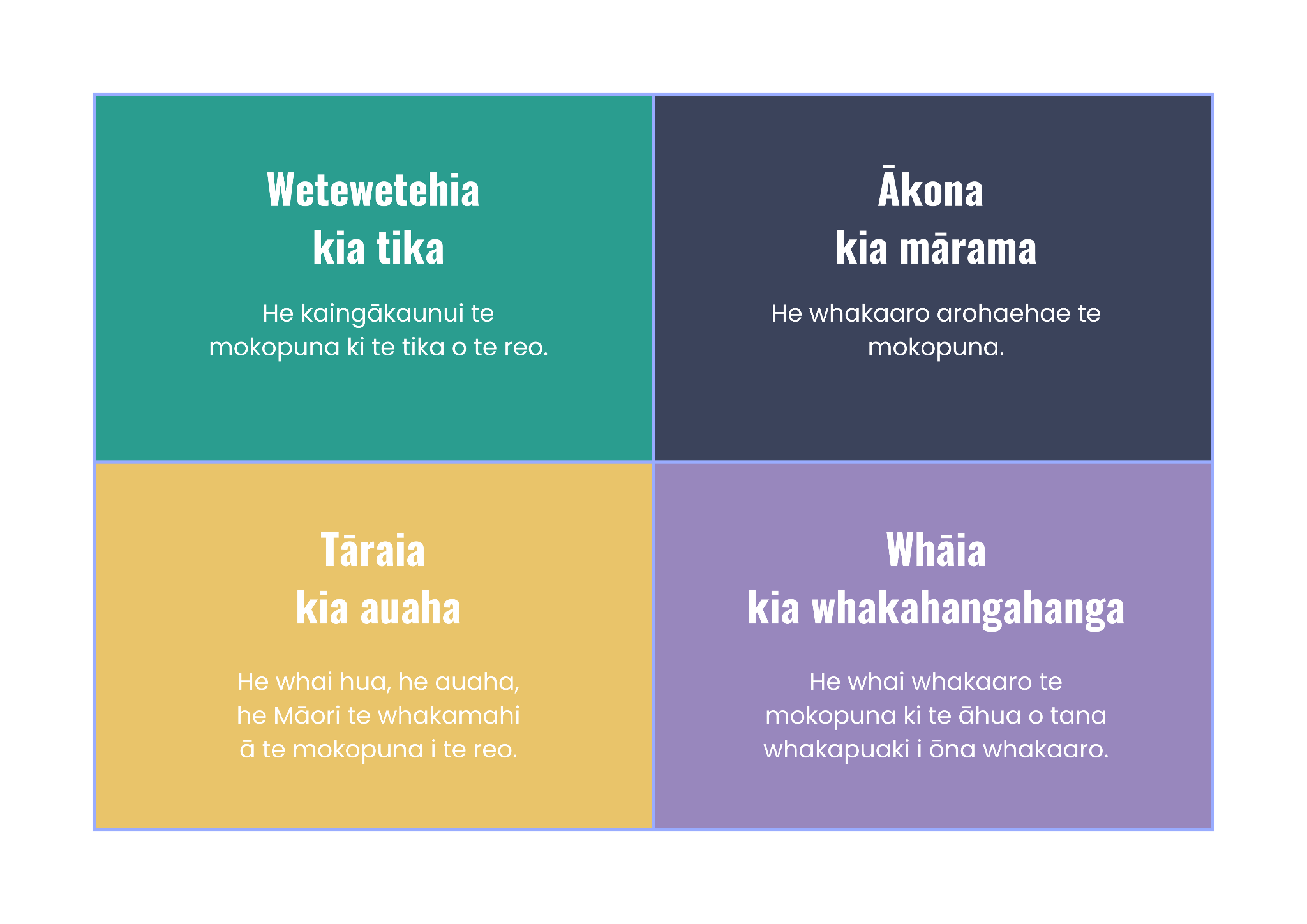I NGĀ MARAMA E ONO
TE ARA WHAKAAKO I TE TUHITUHI
Whārangi Ihirangi
Mātua ko te Kōtuitui
Kaiako should explicitly plan to integrate the language strands, whakarongo, kōrero, pānui, tuhituhi, mātakitaki and whakaatu.
Language competency is critical for ākonga to successfully access the curriculum and learning that is relevant to their world.
It is important to make connections across the curriculum between prior knowledge and new knowledge by providing a range of stimulating and engaging experiences.
I ngā marama e ono: Te Ara Whakaako i te Tuhituhi
Te whakamāramatanga me ngā āhuatanga
TUHITUHI NGĀTAHI | SHARED WRITING
Tuhituhi Ngātahi should be used as the primary instructional approach. This is a collaborative writing experience between a kaiako and a group of ākonga. The kaiako takes on the role of scribe, recording the ideas and contributions of the ākonga. This approach allows the kaiako to model being a writer.
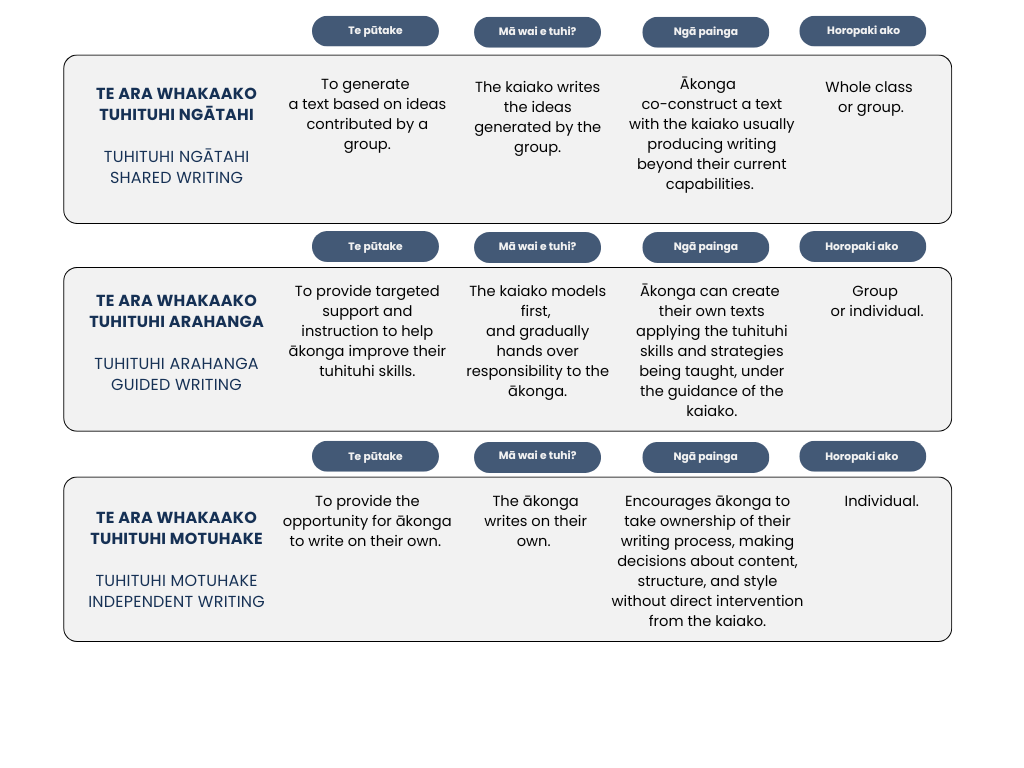
I ngā marama e ono: Te Whakahaere i te Tuhituhi Ngātahi
In the first six months, ākonga should be encouraged to produce 'writing' for the following purposes:
To recount a personal experience.
To retell a simple narrative.
They should also be exposed to other purposes such as:
To describe something or someone.
To provide instructions to carry out a simple task.
To acknowledge a person.
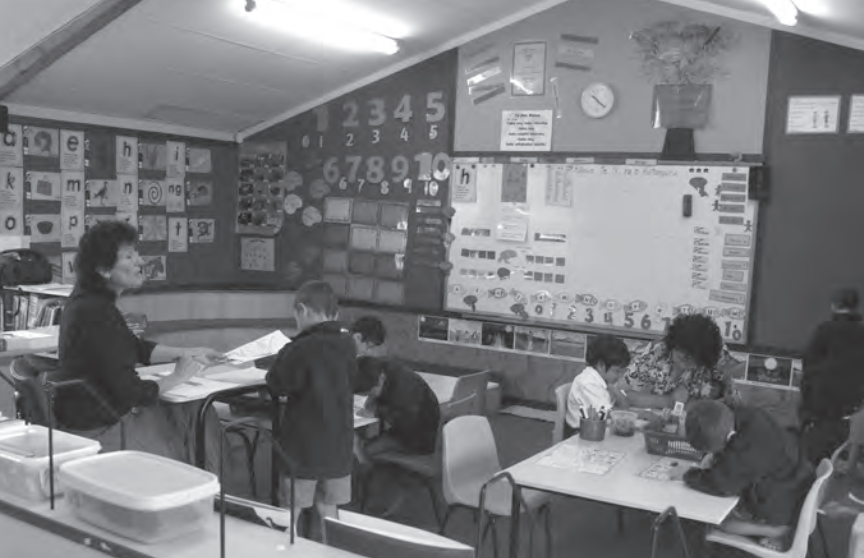
I ngā marama e ono: Te Tukanga Tuhituhi Ngātahi
The shared writing process for 6 month (emerging writers) involves collaborative writing experiences guided by a kaiako. The lesson structure of a shared writing process might include:
Settling Time
Transition smoothly to a focused writing session.
Review a previously written text or teaching point.
Prepare for the new learning focus.
Vocabulary Building Time
Learn new words, phrases, and concepts through explanations and examples.
Build vocabulary to contribute effectively to writing tasks.
Teaching Time
Understand the purpose and key ideas for the writing.
Watch the kaiako model and demonstrate the writing task.
Contribute to discussion about what is to be included in the writing.
Read and Question Time
Review the completed text with the kaiako by reading it aloud.
With support check the clarity of the message in the writing.
With support identify and revise parts that need improvement.
I ngā marama e ono: Te Tuhinga Māhorahora
Write everyday about topics of their choice.
Write about their own experiences, interests and things they know.
Use writing to express thoughts, feelings and ideas.
Take a piece of their chosen free-writing through the writing process and prepare for publishing.
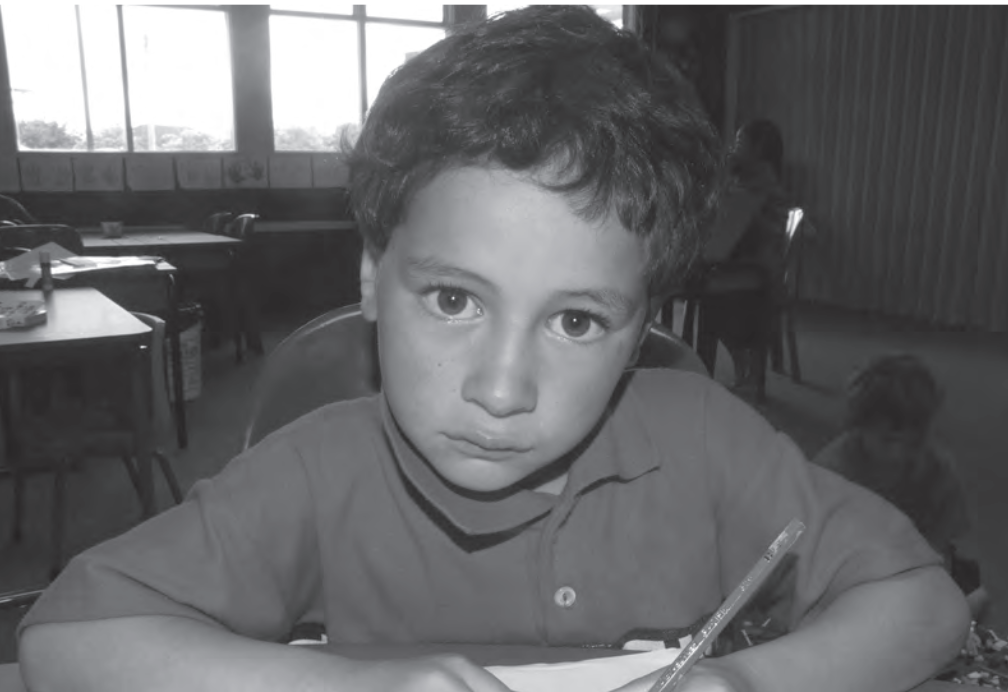
I ngā marama e ono: Ngā Toi Mokopuna - Tuhituhi
This section outlines the skills, strategies and knowledge required in tuhituhi for the first six months.
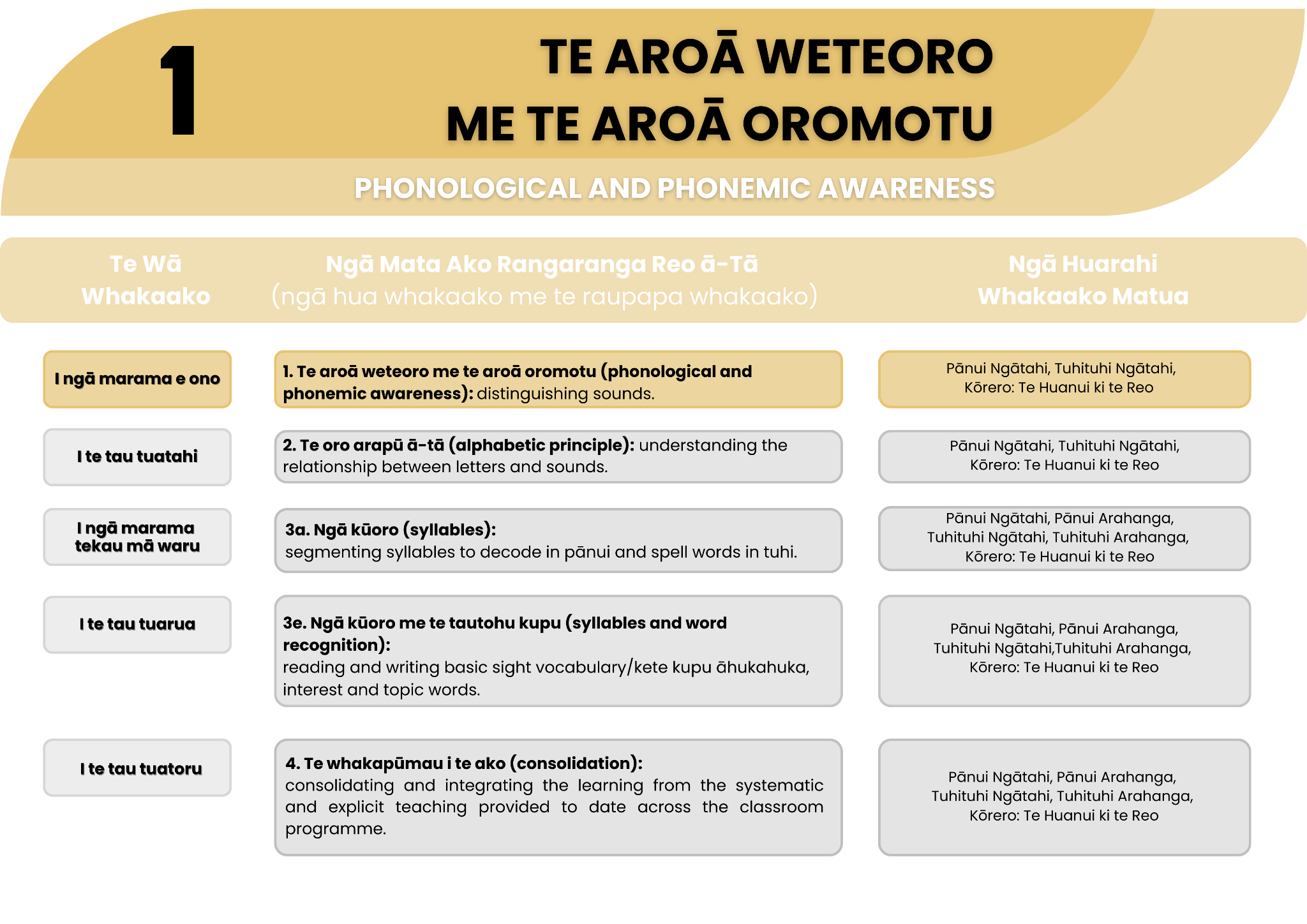
Wetewetehia kia tika
He kaingākaunui te mokopuna ki te tika o te reo.
Te whāinga
Ākonga learning focuses on accurately using and understanding basic vocabulary and sentence structures.
Rangaranga Reo ā-Tā
Ngā Tohu Ako
Te ngako o te whāinga
During a tuhituhi lesson, support the ākonga to:
(Rangaranga Reo ā-Tā: Te Aroā Weteoro me te Aroā Oromotu) Distinguish sounds.
Spell their name correctly including using capitals where required.
Accurately copy other often used words from classroom displays (e.g. days of the week).
'Write' from left to right and top to bottom.
Recognise and use fullstops.
Use some basic sight words and words of personal interest (Note: These are likely to be approximations as ākonga master the letter sound relationship).
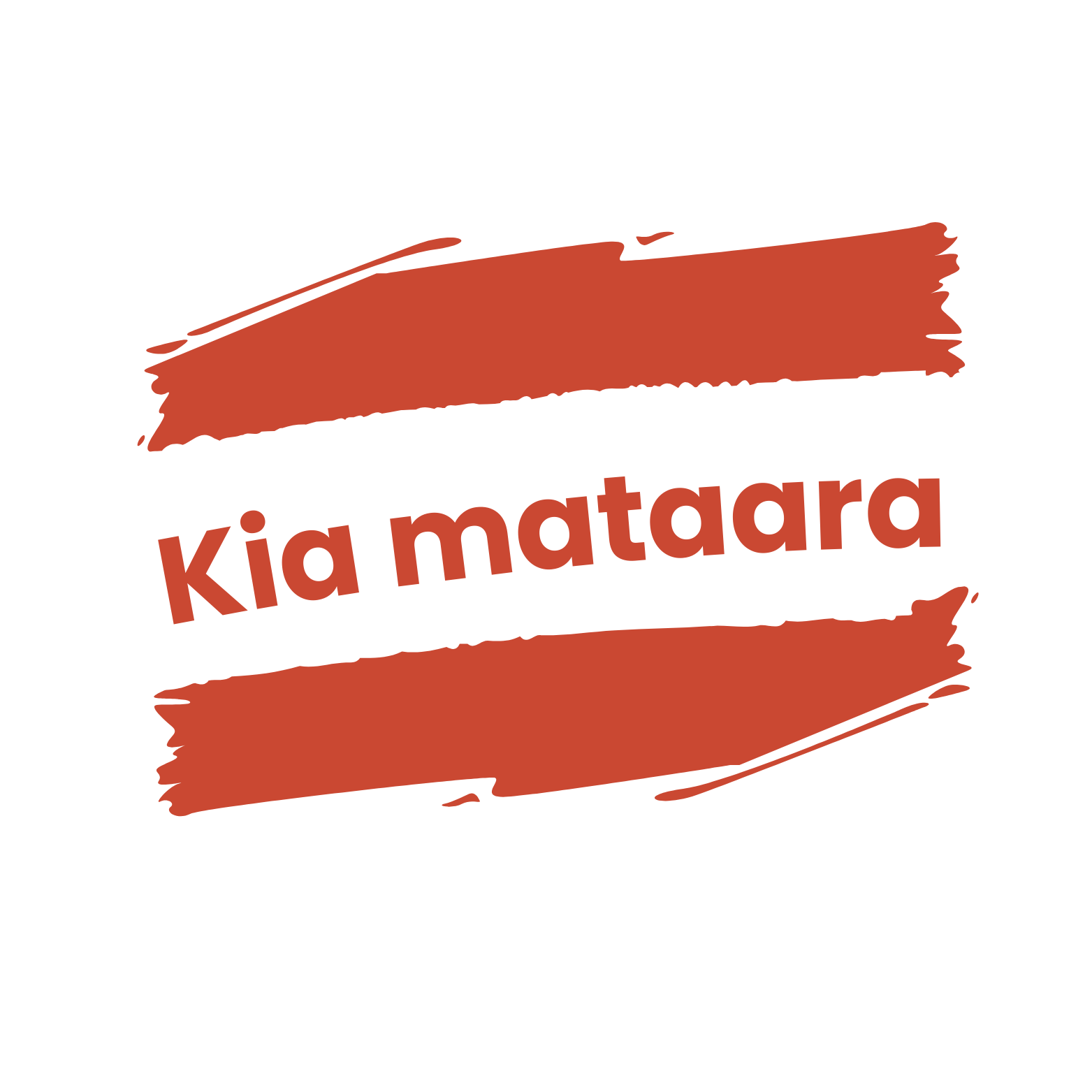
By the end of six months, ākonga need to be able to distinguish the sounds in te reo Māori (phonemes).
Akona kia mārama
He whakaaro arohaehae te mokopuna.
Te whāinga
Ākonga learning focuses on developing basic comprehension skills and strategies.
Ngā Tohu Ako
Te ngako o te whāinga
During a tuhituhi lesson, support the ākonga to:
Talk about the topic before starting to write.
Talk or draw to generate ideas for their writing.
Dictate some basic sentence beginnings (He, Ko, Kei te…).
Talk about their writing in order to clarify the message.
Understand that writing is published for others to read.
Talk about what they are learning.
Whāia kia whakahangahanga
He whai whakaaro te mokopuna ki te āhua o tana whakapuaki i ōna whakaaro.
Te whāinga
Ākonga learning focuses on developing basic interpersonal communication skills.
Ngā Tohu Ako
Te ngako o te whāinga
During a tuhituhi lesson, support the ākonga to:
Talk about the purpose and audience as part of the planning for tuhituhi during tuhi ngātahi.
Share their writing and respond to the writing of others with support.
Tāraia kia auaha
He whai hua, he auaha, he Māori te whakamahi ā te mokopuna i te reo.
Te whāinga
Ākonga learning focuses on discovering ways to express thoughts and imagination.
Ngā Tohu Ako
Te ngako o te whāinga
During a tuhituhi lesson, support the ākonga to:
Attempt to spell words using their developing letter-sound knowledge.
Say a sentence aloud before writing it.
Use the writing of the kaiako as a model to create their own texts.
I ngā marama e ono: Ngā Tauira Tuhituhi
In the first 6 months, ākonga are likely to be writing at Ka Oho stage. Each piece of writing here is arranged in order of skill development from top left to bottom right. These ākonga were prepared to 'read' their writing back to the kaiako, even though in some cases the meaning changed between readings.
They had therefore developed the fundamental idea that print conveys meaning, but had not yet developed the understanding that print is a fixed code. All of these ākonga had something important to say about themselves and their world.
The following are indicative examples only.
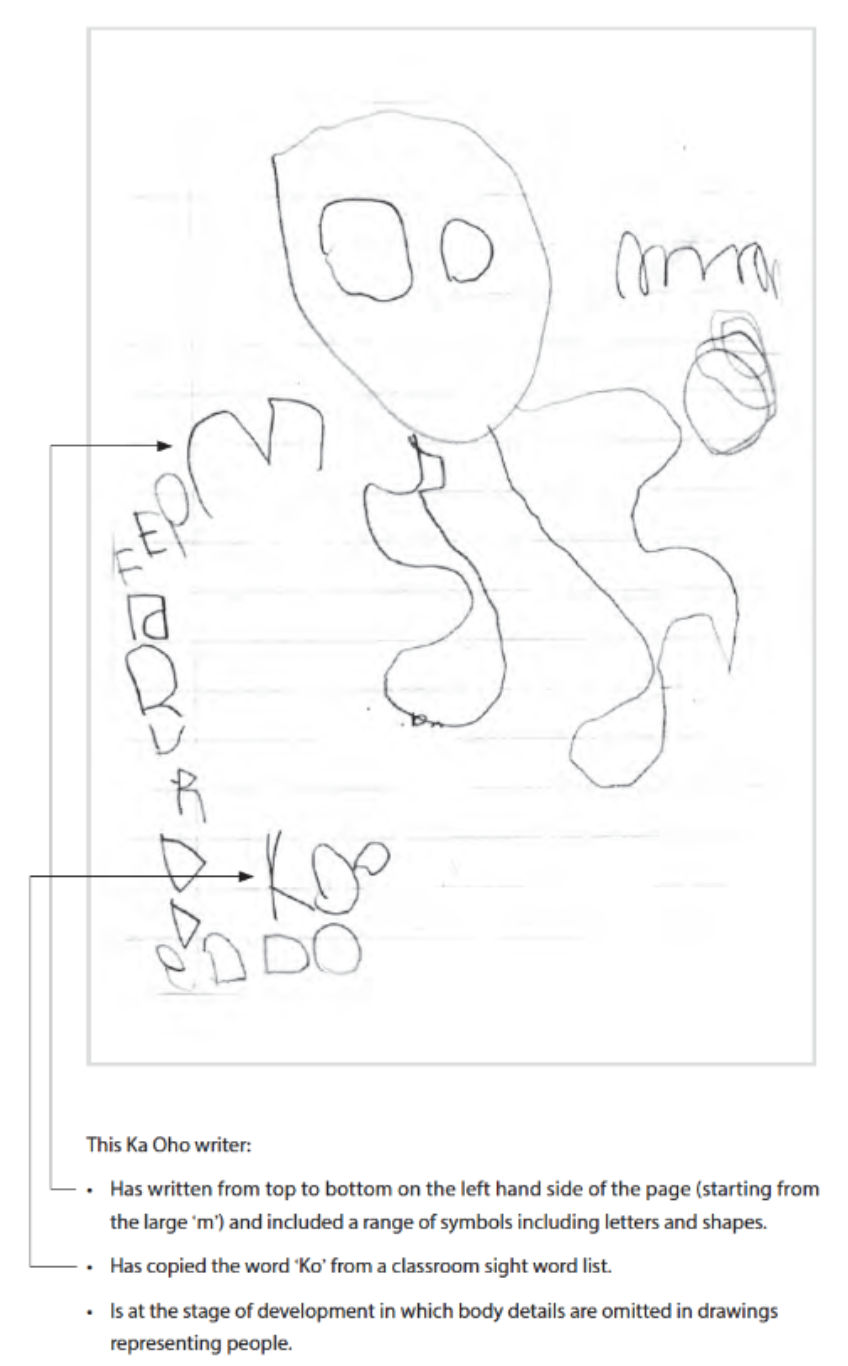
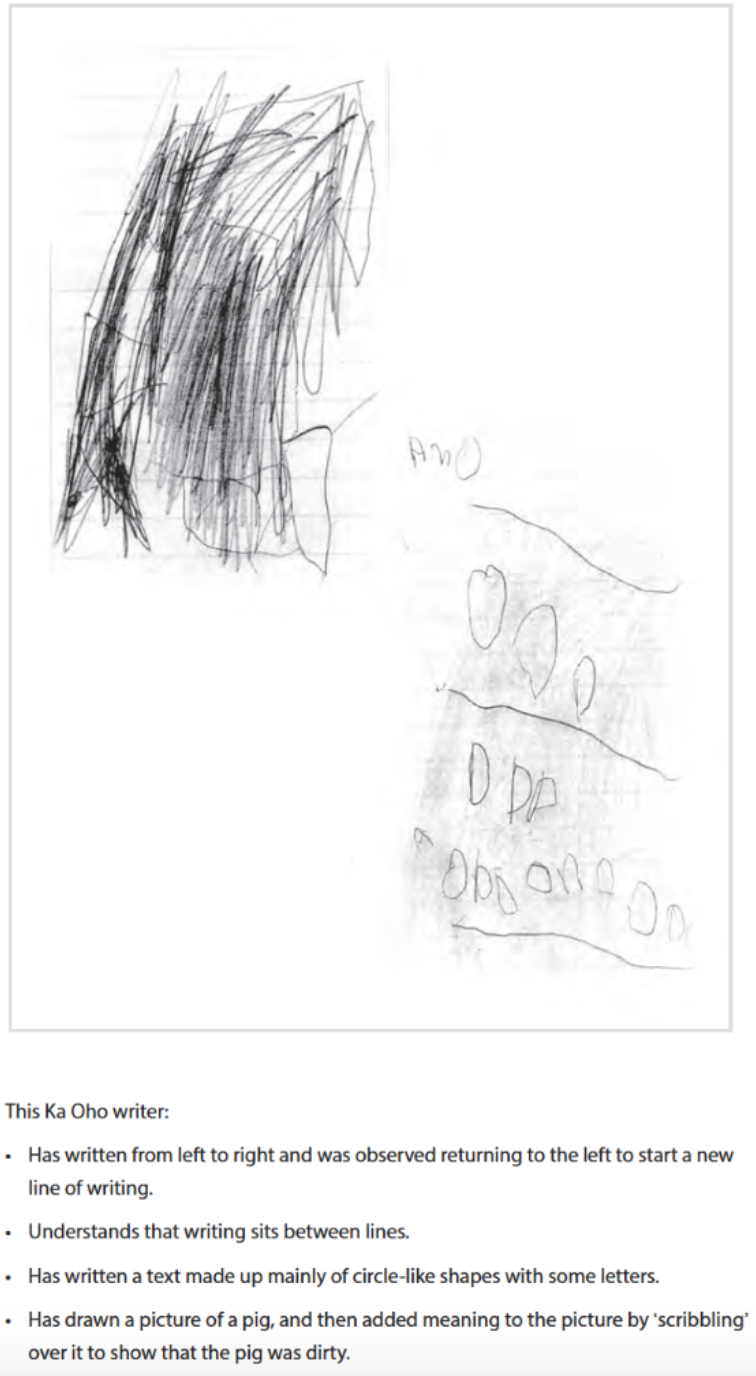
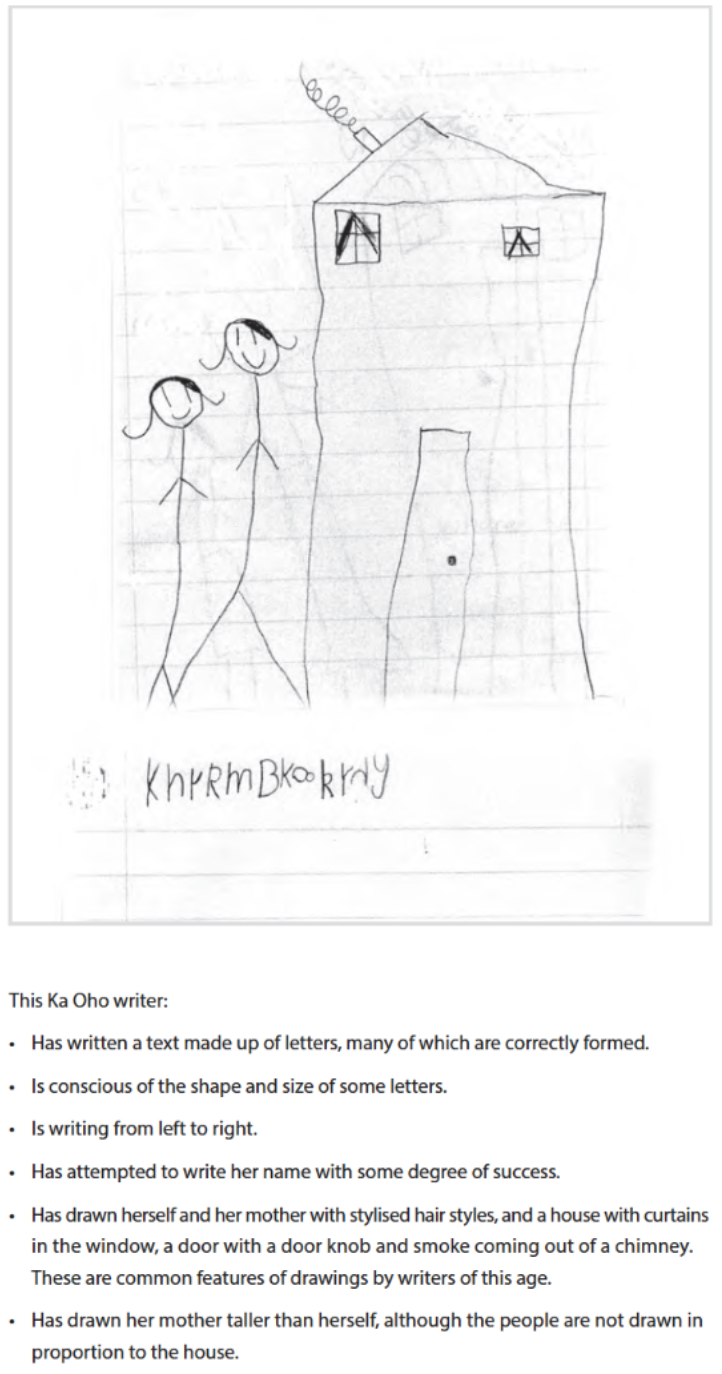
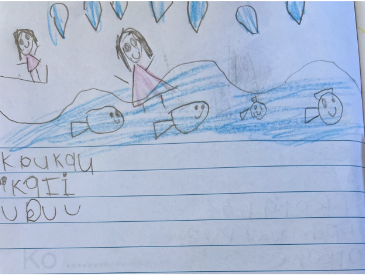
Ref: Tauira Samples | Richmond Road School. This ākonga has copied words from the classroom displays.
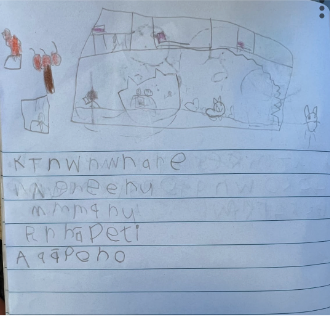
Ref: Tauira Samples | Richmond Road School. This ākonga has included words from classroom displays in amongst their own attempts at creating a message.
I ngā marama e ono: Te Aromatawai i te Tuhituhi
Aromatawai ō te ako (of learning), and aromatawai mō te ako (for learning).
Aromatawai should be personalised to reflect the reality that ākonga are at different stages in their learning journey and move through that journey at different speeds. This includes valuing neurodiversity (i.e. that all brains function differently) which is particularly important for neurodivergent ākonga.
Ākonga should be encouraged and supported to understand the purpose of aromatawai and be active participants in gathering information through aromatawai activities such as self-reflection, self assessment and the creation of portfolios of work that demonstrate their learning.
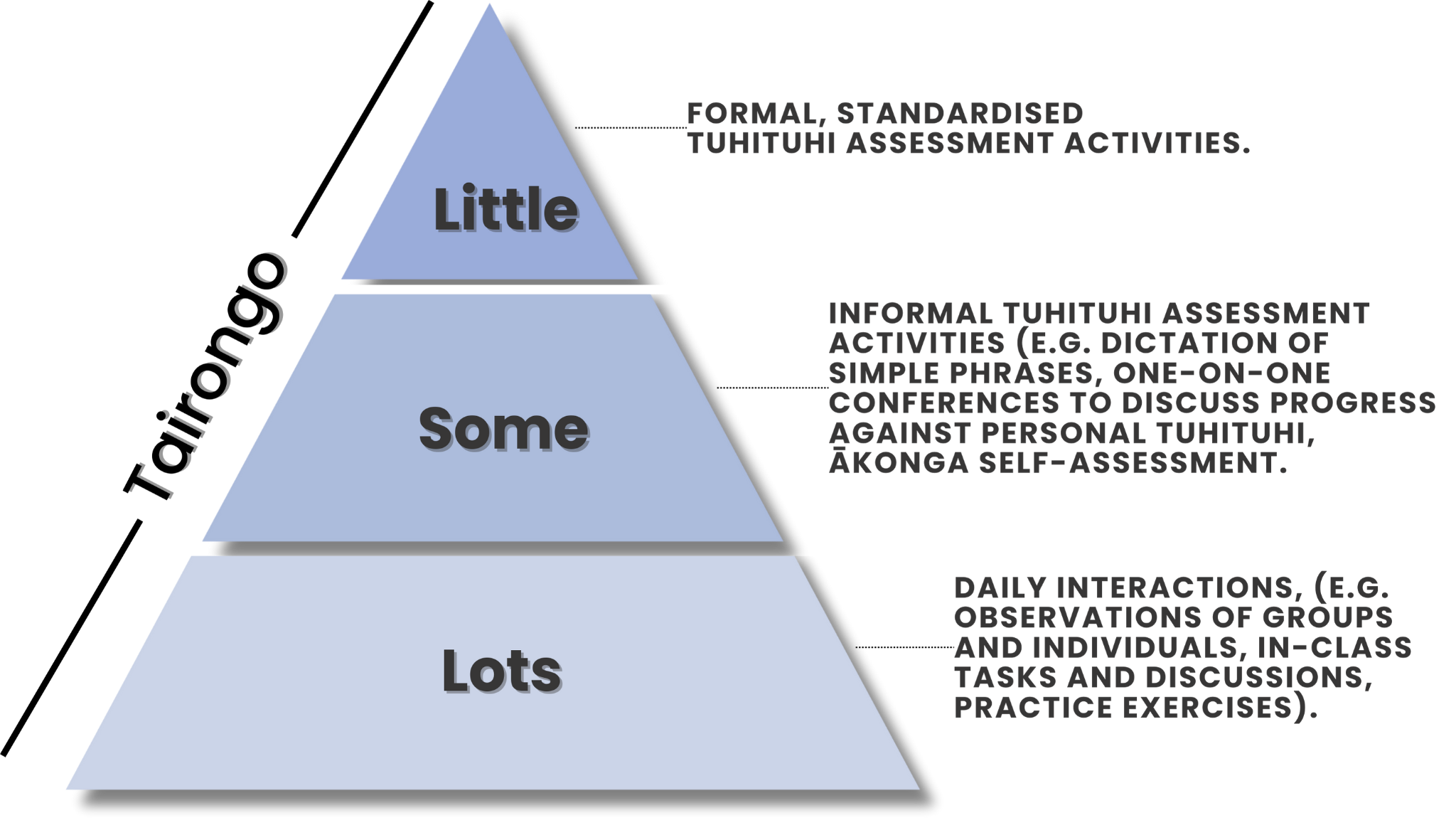
MAHI AROMATAWAI: What to look/listen for, ākonga are:
Rehearsing aloud what they intend to write.
Confident to draw and use symbols to record their ideas.
Willing to ‘read’ aloud what they have ‘written’ and share their efforts with others.
I ngā marama e ono: He Huarahi Tuhituhi Anō
Tuhi atu, tuhi mai | Writing to:
Involves a kaiako or more skilled writer periodically crafting a written response to content an ākonga as produced.
The focus is on making a connection with the ākonga as a writer.
Tuhi tautokotahi | Writing with:
Involves everyone in the class (including the kaiako) writing during scheduled whole class 'free writing' sessions.
The focus is for everyone to write to meet their own personal needs.
Tuhi motuhake | Independent writing:
Refers to ākonga generating content on their own.
The focus is on fostering a love of writing. The writer also has the opportunity to practice their knowledge, skill and strategies without direct support from the kaiako.
